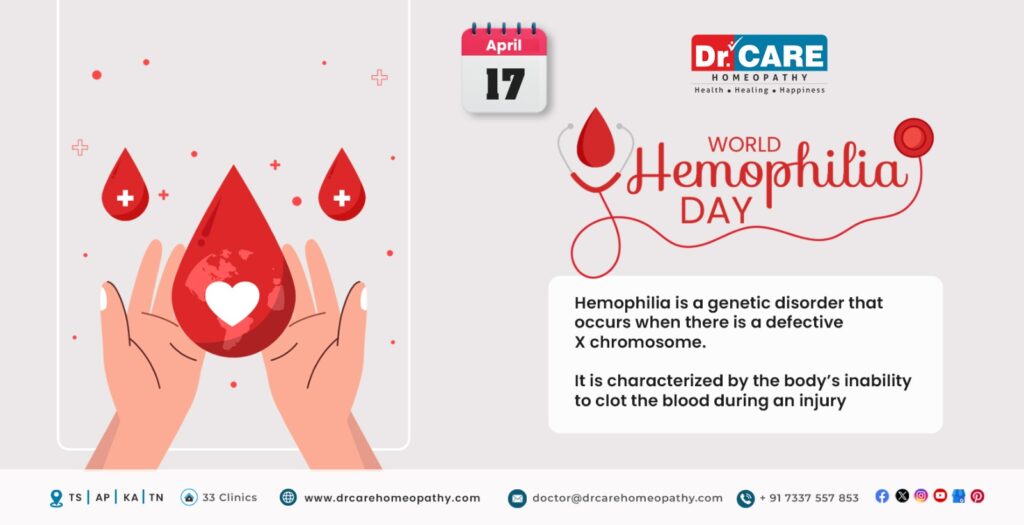World Haemophilia Day is celebrated on April 17 of every year. Hemophilia is seen in 1 of every 5000 men. On this World Haemophilia Day, let’s learn more about this disorder and raise awareness among the people around us. Before we learn more about hemophilia and see how we could treat it with homeopathy, let’s take a look at the significance of World Haemophilia Day
Definition of Haemophilia
Haemophilia is a Greek word coined by two separate words:
Haem – is blood and Philia – love
So the word means “love for bleeding” and this relates to how bleeding does not stop in the patients who are affected with hemophilia.
World Haemophilia Day 2024 Theme – Equitable Access for All
This year’s World Haemophilia Day theme focuses on the fact that every haemophilic patient needs to receive fair and equal access to treatment for the disorder. This vision is to ensure that every person irrespective of age, sex, hemophilia type, or race gets the right support they need to fight the disease. The World Federation of Hemophilia is backed by other health organizations and together, they are focusing on building better healthcare for the communities suffering from hemophilia.
Older World Haemophilia Day Themes
World Haemophilia Day 2023 Theme: Together We Progress
This theme encouraged the general public to become aware of hemophilia and work together to make life better for people suffering from hemophilia.
World Haemophilia Day 2022 Theme: Connections for Care
In 2022, the World Federation of Haemophilia chose this theme to ensure people suffering from hemophilia had the right connections for better cure and care.
World Haemophilia Day 2021 Theme: Adapting to Change
In 2021, the organization wanted to let the people with haemophilia know that they were not forgotten despite the fight against COVID-19 and ensured such people received the right support during trying times.
World Haemophilia Day 2020 Theme: Get Involved
The theme for 2020 mainly focussed on not just making the general public aware of haemophilia, but also making it a necessity that people understood the disorder better by getting involved with haemophillic patients.
History of Haemophilia
The haemophilia disorder was first discovered in the 10th century when men and women died due to continuous bleeding when they had minor injuries. The disorder was initially called Abulcasis and no cure was found due to medical and technical limitations at that time.
In 1803, Dr John Conrad Otto from Philadelphia began studying more about the disorder and concluded that it occurred due to a genetic mismatch and was passed down to males from their mothers. In 1937, hemophilia was categorized as hemophilia A and hemophilia B. Although the research never paused, there was no cure found during these investigations.
So What is Haemophilia after all?
Wounds don’t stop bleeding? It could be hemophilia. Hemophilia is a genitally caused disorder in which the blood clots are not formed after an injury. Blood clots are generally formed when the blood has proteins. Hemophilia occurs due to the lack of sufficient proteins in the blood. Thus the people who are affected with hemophilia bleed for a longer time than normal people. The bleeding could occur both externally and internally. Sometimes, excessive bleeding could be life-threatening and hence proper care and treatment are very crucial.
Causes of Haemophilia:
As you are aware hemophilia is a genetic disorder, it is genetically passed on from the parent to the child. The faulty gene occurs in the X chromosome. Males have XY chromosomes and if the X chromosome is faulty, they tend to have hemophilia. Women have XX chromosomes and in most cases, if they have a faulty X chromosome, they tend to be the carriers of the disorder. In some cases, hemophilia occurs due to spontaneous mutation of the X chromosome, and in such cases, the disorder is not inherited by the parent.
Hemophilia occurs in middle-aged or elderly people or younger women who have recently given birth or are in their final stage of pregnancy. With proper treatment, this condition can be suppressed.
Conventional Treatment for Haemophilia:
The most common conventional treatment for hemophilia is the transfusion of proteins to the blood. The people suffering from hemophilia A will have VIII transfusions and the people suffering from hemophilia B undergo IX transfusion. These are very expensive and can damage the immune system. Such patients become more susceptible to infections like AIDs, Hepatitis C, and other contagious infections. Homeopathy has an alternate treatment.





